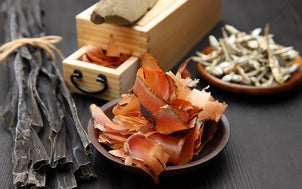Dashi: The Essence of Japanese Cuisine

Image source: https://zhuanlan.zhihu.com/p/20189799
Written by Kevin Kilcoyne
Many great soup stock recipes start with some vegetables, alliums, and meat. Combined with time and attention, those ingredients simmer and reduce, concentrating the rich flavors and bringing out the umami of the ingredients. However, long hours spent skimming foam and fat off the top of a bubbling stock pot often has home cooks reaching for cans or packages of store-bought stock (which is totally fine!) at the expense of missing out on all that rich flavor and nutrition.
So, one might ask, how would you go about achieving depths of flavor from a homemade stock without all the hassle? The answer might lie in the centuries-old backbone of Japanese cuisine: dashi (だし, 出汁.)

Image source: https://erecipe.woman.excite.co.jp/article/E1504590504201/
In Japanese cuisine, dashi is the main stock of choice and can be made from several ingredients: kombu (dried kelp), katsuobushi (dried skipjack/bonito tuna flakes), iriko or niboshi (dried anchovies or sardines), and dried shiitake mushrooms. Although these ingredients can be used individually, they’re usually combined in some way to achieve a deeper umami flavor. The most common preparation for dashi is a simple combination of kombu and katsuobushi, known as awase dashi (合わせだし) - awase meaning mixed or combined - and can be prepared in a mere twenty minutes.
Other forms of dashi can equally as straightforward and unique in their own ways.

Image source: https://odashi.co.jp/kombu-howto/
Kombu dashi is just that, dashi made from kombu. It has a subtle taste and pairs well with seafood-based recipes, though it can be used in a variety of other recipes and is vegan/vegetarian friendly.

Image source: https://shop.ninben.co.jp/blog/?p=511
Katsuo dashi is a soup stock made by steeping the shaved flakes of katsuobushi in hot water. It has a rich, deep, even smoky, aromatic flavor originating from the dried fermented skipjack/bonito tuna it’s made from. That depth pairs well with simmered dishes as well as vegetable-based dishes and can be a great base for udon or soba.

Image source: https://odashi.co.jp/niboshi-howto/
Iriko or niboshi dashi is a strongly fishy stock made from dried baby anchovies or sardines, which also pairs well with noodle dishes, simmered vegetable dishes, but because of that fishiness is not recommended for seafood-based dishes. The strong fishy taste of this dashi makes it a great addition to shoyu broths that have a strong, pronounced umami flavor. Additionally, iriko and niboshi dashi are commonly used as a base for miso soup.

Image source: https://www.kagome.co.jp/vegeday/eat/201711/8501/
And yet another recipe for dashi is shiitake dashi, which is made from the soaking liquid when rehydrating dried shiitake mushrooms. Compared to the other dashi, shiitake dashi is fairly mild in flavor so either kombu or katsuo dashi is usually added to give it more depth. That being said, the rich earthiness brought by the shiitake makes it great for adding to some more traditional washoku recipes like chawanmushi (a stramed egg custard) and takikomigohan (a rice dish that has various seasonal vegetables and often some meat cooking along with the pot of rice.)



Image sources: https://www.kamada.co.jp/recipe.2117.php; https://www.sbfoods.co.jp/recipe/detail/07358.html; https://mi-journey.jp/foodie/33755/
The ubiquity of dashi in Japanese cuisine goes to show how versatile of an ingredient it is on its own. It is used as a base for soups, hot pots, simmered dishes, and even as a seasoning all on its own.
That being said, some of the ingredients that go into making dashi can be either hard to come by or expensive when they are. They can also be a little intimidating (looking at you iriko and niboshi) so another alternative to making dashi yourself is to opt for a powdered version.
Now of course making the dashi from scratch, like any stock, is always best (as this article has tried to show) as it will result in a much fresher, deeper flavor, and gives you more control on what goes into your broth. Even so, there are great single serving sized packets and small containers of dashi powder that can be measured out like any other ingredient.
Whichever method of making or incorporating dashi into your cooking you choose, know that you can’t go wrong. Finding your favorite method of using dashi can be a part of the process in exploring what washoku is to you.
To find out more about what washoku is and what that might mean to you, check out our previous article Washoku: Japanese Cuisine.
About the author: The spark that lit Kevin Kilcoyne’s interest in Japanese culture began in elementary school through a friendship with his then classmate Keisuke. Since then, that passion has evolved and bloomed to encompass more than just video games and manga, leading Kevin to live in Japan as a participant of the JET program. During his time in Japan, Kevin sought out as many foods as he could, the experiences and taste memories lingering long after they had gone. Now he is forging a path to link his passions for Japanese food, history, and visual culture and is planning for his return to live in Japan once again. For now, you can find Kevin on Instagram (@kevinjkilcoyne) where he posts his photography and illustration work. Keep an eye out for more posts and updates as Kevin delves more deeply into his passions for writing and food.




